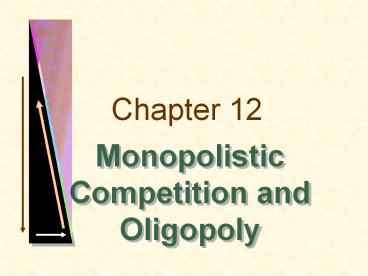Monopolistic Competition and Oligopoly - PowerPoint PPT Presentation
Title:
Monopolistic Competition and Oligopoly
Description:
Oligopoly. Equilibrium in an Oligopolistic Market ... In oligopoly the producers must consider the response of competitors when ... Oligopoly. Nash Equilibrium ... – PowerPoint PPT presentation
Number of Views:246
Avg rating:3.0/5.0
Title: Monopolistic Competition and Oligopoly
1
Chapter 12
- Monopolistic Competition and Oligopoly
2
Monopolistic Competition
- Characteristics
- 1) Many firms
- 2) Free entry and exit
- 3) Differentiated product
3
Monopolistic Competition
- The amount of monopoly power depends on the
degree of differentiation. - Examples of this very common market structure
include - Toothpaste
- Soap
- Cold remedies
4
A Monopolistically CompetitiveFirm in the Short
and Long Run
/Q
/Q
Short Run
Long Run
Quantity
Quantity
5
Comparison of Monopolistically CompetitiveEquilib
rium and Perfectly Competitive Equilibrium
Monopolistic Competition
Perfect Competition
/Q
/Q
Quantity
Quantity
6
Oligopoly
- Characteristics
- Small number of firms
- Product differentiation may or may not exist
- Barriers to entry
7
Oligopoly
- The barriers to entry are
- Natural
- Scale economies
- Patents
- Technology
- Name recognition
8
Oligopoly
- The barriers to entry are
- Strategic action
- Flooding the market
- Controlling an essential input
9
Oligopoly
- Management Challenges
- Strategic actions
- Rival behavior
- Question
- What are the possible rival responses to a 10
price cut by Ford?
10
Oligopoly
- Equilibrium in an Oligopolistic Market
- In perfect competition, monopoly, and
monopolistic competition the producers did not
have to consider a rivals response when choosing
output and price. - In oligopoly the producers must consider the
response of competitors when choosing output and
price.
11
Oligopoly
- Equilibrium in an Oligopolistic Market
- Defining Equilibrium
- Firms do the best they can and have no incentive
to change their output or price - All firms assume competitors are taking rival
decisions into account.
12
Oligopoly
- Nash Equilibrium
- Each firm is doing the best it can given what its
competitors are doing.
13
Oligopoly
- The Cournot Model
- Duopoly
- Two firms competing with each other
- Homogenous good
- The output of the other firm is assumed to be
fixed - Firms decide simultaneously how much to produce
14
Firm 1s Output Decision
P1
Q1
15
Reaction Curves and Cournot Equilibrium
Q1
100
75
50
25
Q2
25
50
75
100
16
Oligopoly
- Questions
- 1) If the firms are not producing at the
Cournot equilibrium, will they adjust until the
Cournot equilibrium is reached? - 2) When is it rational to assume that a
competitors output is fixed?
17
Oligopoly
The Linear Demand Curve
- An Example of the Cournot Equilibrium
- Duopoly
- Market demand is P 30 - Q where Q Q1
Q2 - MC1 MC2 0
18
Oligopoly
The Linear Demand Curve
- An Example of the Cournot Equilibrium
- Firm 1s Reaction Curve
19
Oligopoly
The Linear Demand Curve
- An Example of the Cournot Equilibrium
20
Oligopoly
The Linear Demand Curve
- An Example of the Cournot Equilibrium
21
Duopoly Example
Q1
The demand curve is P 30 - Q and both firms
have 0 marginal cost.
Q2
22
Oligopoly
Profit Maximization with Collusion
23
Oligopoly
Profit Maximization with Collusion
- Contract Curve
- Q1 Q2 15
- Shows all pairs of output Q1 and Q2 that
maximizes total profits - Q1 Q2 7.5
- Less output and higher profits than the Cournot
equilibrium
24
Duopoly Example
Q1
30
Q2
30
25
First Mover Advantage--The Stackelberg Model
- Assumptions
- One firm can set output first
- MC 0
- Market demand is P 30 - Q where Q total
output - Firm 1 sets output first and Firm 2 then makes an
output decision
26
First Mover Advantage--The Stackelberg Model
- Firm 1
- Must consider the reaction of Firm 2
- Firm 2
- Takes Firm 1s output as fixed and therefore
determines output with the Cournot reaction
curve Q2 15 - 1/2Q1
27
First Mover Advantage--The Stackelberg Model
- Firm 1
- Choose Q1 so that
28
First Mover Advantage--The Stackelberg Model
- Substituting Firm 2s Reaction Curve for Q2
29
First Mover Advantage--The Stackelberg Model
- Conclusion
- Firm 1s output is twice as large as firm 2s
- Firm 1s profit is twice as large as firm 2s
- Questions
- Why is it more profitable to be the first mover?
- Which model (Cournot or Stackelberg) is more
appropriate?































